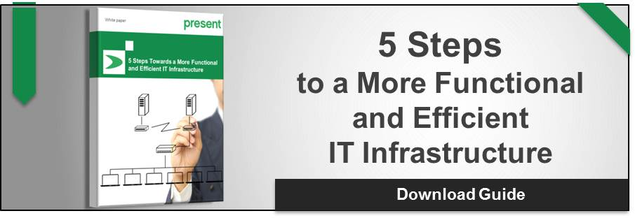Present Blog – IT Thought Leadership
Blog Present-IT thought leadership
Blog Present-IT thought leadership
IT thought leadership blog for CIOs and CTOs in Canada seeking resources to drive IT as a business contributor: hybrid cloud, infrastructure, managed services and security and IT recruitment.
 We recently talked about converged infrastructures, also known as integrated systems, and how these environments help break down silos within companies.
We recently talked about converged infrastructures, also known as integrated systems, and how these environments help break down silos within companies.
There is another level in virtualized environments that surpasses the expectations of all other infrastructures, and these are hyper-converged systems.
Difference between convergence and hyper-convergence
A converged system is a set of components (servers, storage devices, network) combined in an infrastructure solution powered by software and a unified management platform. Among the solutions that permit this unified management, the most recognized are Cisco UCS and IBM Flex. Yet even though the range of services is controlled from a single management console, the hardware infrastructure components remain separate.
A hyper-converged system includes the same components (server, storage and network) in a single chassis with a layer of management and automation. In hyper-converged systems, the design of the environment is devised in a cluster. In this environment, each node has access to the storage of all the other nodes.
This solution allows access to data and server applications through a single interface.
3 major advantages of hyper-converged systems
#1: The hyper-converged infrastructure for better density
Since all the components are in the same housing, a better density is obtained with a hyper-converged infrastructure. The increased density often allows more operations in less physical space.
For example, in a converged infrastructure constructed in an enterprise 42U rack, the storage could use 6U and the systems 8U, for a total of 14U. Conversely, in a hyper-converged system, these components would fit in a space of 4U.
This space saving equally reflects a decrease in the release of heat from the devices and therefore a diminished need in terms of cooling, hence electricity.
#2: The hyper-converged infrastructure for better performance
What contributes to the high performance of hyper-converged infrastructures, among other things, is the distribution of VMs in a FileSystem managed and optimized by the cluster. For example, Nutanix is designed this way and allows for the integration and direct relationship between compute and storage. This allows quick access to data due to their proximity to compute. Consequently, the movement of data between the various tiers of storage is also optimized.
Of course, the speed of data transfer depends partly on the type of disc used. The ultra-fast SSD or Flash type drives will provide the best performance, while the mechanical drives (spinning drives) will be slower. However, these two technologies are part of a hyper-converged system.
#3: The hyper-converged infrastructure for ease of management and simpler scalability
The very design of a hyper-converged infrastructure is focused on simplicity. Given that compute, network and storage elements are all integrated in one housing, this avoids having a person who will manage each component separately. The distributed FileSystem alone manages all exchanges between the different tiers of storage.
Compared to a traditional or converged infrastructure, a hyper-converged environment will bring several types of gains:
• Few components to support
• Simplified deployment
• Predictability of performance
• Easy growth with the installation of additional nodes
• Automated configuration of new nodes
• Ease of scalability based on business needs
With most traditional integrated systems, these actions are multiplied. If you add a component, it must be configured separately and then connected to the other components.
Important
There are many myths and misconceptions around hyper-convergence since it is a type of environment that has only been developed in recent years. These misconceptions revolve mainly around the cost of implementation, the complexity and who these solutions are for.
The choice of a hyper-converged system relies as much on strategic considerations for optimisation as it does on technical features.
© freshidea - Fotolia.com
About Blog
The right use of technology addresses business challenges and drives business growth in all areas of an enterprise. We hope this blog will offer insight into developing strategies and tactics to enable you to identify those key drivers of growth and keep pace with and anticipate the rapid technology change of today.
Posts by Topic
- IT infrastructure (116)
- IT security (92)
- IT Innovation (59)
- Trends (51)
- Cloud (47)
- Managed services (46)
- Mobility (38)
- Digital transformation (29)
- CIO/IT leaders (28)
- Events (28)
- News (23)
- Microsoft 365 (17)
- Security (17)
- IBM (16)
- Disaster recovery (DR) (14)
- High availability (12)
- Recruitment (12)
- Storage (12)
- Big Data (11)
- Collaboration (11)
- AI (9)
- Case study (9)
- Office 365 (9)
- BYOD (8)
- Customer Experience (8)
- Hybrid Cloud (7)
- Current events (6)
- SAP Hana (5)
- Business intelligence (BI) (4)
- Converged infrastructure (4)
- Convergence / Hyper-convergence (4)
- Virtualization (4)
- Copilot (3)
- Future of retail (2)
- Retail (2)
- trend (2)
- Backups (1)
- Beacon (1)
- Blog Migrations (1)
- Contests (1)
- Infrastructure TI (1)
- Innovation TI (1)
- IoT (1)
- MDM (1)
- Stockage (1)
- Virtualisation (1)
- blockchain (1)
- cio (1)
- replication (1)
- Étude de cas (1)


